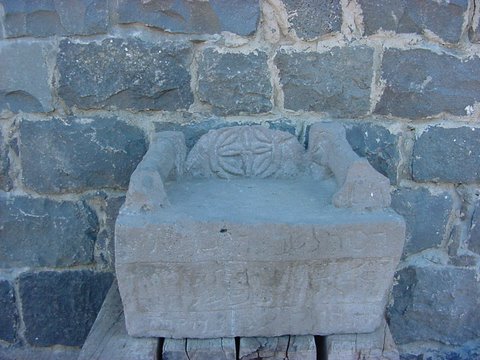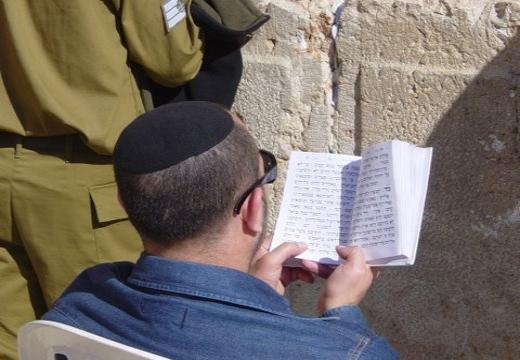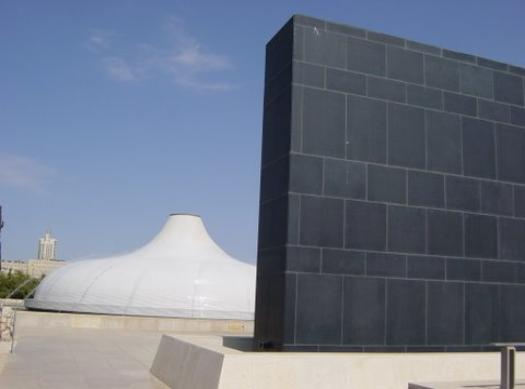-8-
Jesus, Before He Became A Gentile
Jesus was a Jew. He was born of a Jewish mother, and for that reason alone he could qualify for aliya (immigration in Israel) by present standards. He was born in a Jewish town, circumcised according to Jewish law, worshipped in a Jewish synagogue, and read the Jewish law as was customary. He undoubtedly spoke the Hebrew language. 1 Joachim Jeremias remarks that Jesus was “a prophet who completely remained within the limits of Judaism.” 2
Jesus has been pictured in the garb and with the skin coloration of virtually every Gentile people on earth. However, prior to recent decades Jesus was seldom depicted with clearly Jewish features or in a religious Jewish context. The theologian Charlesworth states, “…if two facts are unassailable today, they are Jesus’ deep Jewishness–he was a Jew– and his paradigmatic effect on Jews and Gentiles.” 3
The ancient Galilee boat that could have been used by Jesus and his disciples.
It would shock many Christians today to see Jesus wearing a tallit (a garment with tassles and fringes). Yet, we can be assured that he wore one. Had he not done so, he would have broken the very Law that he came to uphold. The law concerning the wearing of such garments is found in Numbers 15:37-49. These garments were certainly still worn in Jesus time, because along with the discovery of the Dead Sea Scrolls, a tallit was found almost intact. It can be seen on display today at the Shrine of the Book in Jerusalem.
On one occasion a sick woman came and touched what must have been the fringes (tzitzit) of this garment, and in so doing, she was healed (Mk. 6:53-56). Perhaps she was depending upon that phrase in Malachi 4:2, “But for you who revere my name, the sun of righteousness will rise with healing in its wings. And you will go out and leap like calves released from the stall.” The word for “wings” is from the Hebrew root “kanaph,” and can also refer to the wings of the prayer shawl (arba kenafyot) or four wings. 4
EVIDENCE OF HIS JEWISHNESS
There is much evidence of Jesus’ Jewishness in scripture if we take time to search it out and consider it. Jesus was born of Jewish parents and into a devout Jewish home. He was circumcised on the eighth day (Lk. 2:21). After Jesus’ birth, his mother performed the required purification rites by presenting him at the Temple in Jerusalem and by making the necessary sacrifice (Lk. 2:22-24).
Jesus’ parents were faithful in journeying to Jerusalem every year for the feast of Passover (Lk. 2:41). When we remember the distance between Galilee and Jerusalem, and when we consider most people traveled on foot, this was in itself a considerable demonstration of their devotion.
Even as a child, Jesus was deeply attracted to the Temple and was interested in the theological discussions carried on in its precincts. On one of his many trips to Jerusalem, he talked at length with the teachers (Lk. 2:42-49), both answering their questions and asking questions of them. The teachers were astounded at his wisdom since he was only a child of twelve years. His parents were also astounded when they discovered he was not on their caravan headed home. They made a panicky trip back to Jerusalem and were amazed to find him in the Temple.
We learn also from scripture that Jesus was no stranger to synagogue. In Luke 4:16 we read,
He went to Nazareth, where he had been brought up, and on the Sabbath day he went into the synagogue, as was his custom. And he stood up to read.
We learn that it was not only Jesus’ custom to attend the synagogue, but apparently it was quite customary for him to participate in the public reading of scripture as well.
The fourth century synagogue at Capernaum. Some scholars think its
supporting basalt foundation belonged to the synagogue in Jesus’ day.
As an adult, Jesus kept the various Jewish holidays and festivals. He ate the Passover meal with his disciples (Matt. 26:17, cf. Jn. 2:23). In John 5:1, Jesus attended some unnamed feast in Jerusalem. We also read in John’s gospel that Jesus went up to Jerusalem to keep the Feast of Tabernacles (Jn. 7:2,14).
In fact, one of the truly beautiful teachings of the New Testament was made during this festival. It was the teaching related to the giving of the Holy Spirit to Jesus’ followers. Apparently the teaching was based upon one important part of the Temple celebration in ancient times, known as the “Water-drawing Festival.” In this celebration, a young cohen (priest) took a golden pitcher to the Pool of Siloam and filled it with water. He then led a large procession of people as they carried lighted torches and made their way up to the Temple. Upon arriving there, the water was poured upon the altar, and the people broke out into jubilant song and dance.
Jerusalem’s ancient model city pictures the Pool of Siloam in right foreground
The rabbis have connected this celebration with Isaiah 12:3, where it is said, “With joy you will draw water from the wells of salvation.” The rabbis also have said of the Water-Drawing Festival, “He that never has seen the joy of the Beth ha-She’ubah has never in his life seen joy” (Mishnah, Sukkah 5.1). 5
Jesus seems to have used this feast as the backdrop for his teaching. We read:
On the last and greatest day of the Feast, Jesus stood and said in a loud voice, “If anyone is thirsty, let him come to me and drink. Whoever believes in me, as the Scripture has said, streams of living water will flow from within him” (Jn. 7:37-38).
The writer John tells us that Jesus was speaking about the Holy Spirit whom his followers would receive.
It seems that Jesus, being a devout Jew, also kept the lesser festivals. We see him in Jerusalem in winter at the Feast of Dedication (Jn. 10:22). Today we know this winter festival as Hanukkah. Although it was a non-biblical festival, and although it was in winter, with its cold, rain and discomfort, Jesus showed up in Jerusalem for the festival.
We can be sure that Jesus honored the Law. He says of it in Matthew 5:17, “Do not think that I have come to abolish the Law or the Prophets; I have not come to abolish them but to fulfill them.” Sometimes we get the idea that Christ brought an end of the Law. We probably get that idea by not reading far enough in Romans 10:4. In that verse Paul says, “For Christ is the end of the law for righteousness to everyone who believes (NKJV).” He was the end of the law for righteousness, but definitely not the end of the Law.
He no doubt honored the Sabbath. Had he not done so he would have broken the Law. Jesus did have a running battle with the Pharisees concerning what could and could not be done on the Sabbath. It seems that Jesus made a special effort to heal people on the Sabbath, and that was strictly forbidden by the Pharisees and other religious leaders. However, among the Jews there is the teaching of pecuach nefish. By this understanding, most laws can be set aside to save a life. Perhaps Jesus was operating under this principle or one similar to it in his healings.
Jesus seemed to have no argument with many Jewish customs. His argument was with the failure of some Jewish leaders to practice what they themselves taught. Jesus also attacked their prideful abuse concerning these customs. In. Matthew 23:2-3, Jesus instructs his followers to heed what the religious leaders were teaching:
The teachers of the law and the Pharisees sit in Moses’ seat. So you must obey them and do everything they tell you. But do not do what they do, for they do not practice what they preach.
Moses Seat From the Synagogue of Korazin
In Matthew 23:5, Jesus speaks of phylacteries (tiny boxes containing God’s word attached to the foreheads and arms of devout Jews), and he speaks about the borders on Jewish garments. Larsson remarks: “Does Jesus condemn the Jewish custom here? Does he say: ‘They make phylacteries and put them on’? No, He says: ‘They make their phylacteries broad.’” 6 Their actions were a thinly disguised attempt to win the praise of men.
Yes, Jesus was a Jew. He was not a Gentile as we have supposed, and even as we have been taught. It is a rather surprising fact that Jesus avoided preaching and sending out his disciples to Gentiles. With rare exceptions, both he and his disciples ministered only to the House of Israel (Matt. 15:24).
The Northwestern shores of the Sea, looking toward Capernaum, Jesus’ home
In Jesus’ early ministry we see him instructing his twelve disciples not to enter into the way of the Gentiles or go even into the cities of the Samaritans, but only to the people of Israel (Matt. 10:5-6). This is a surprising statement when we realize that much of the area around the Sea of Galilee was in Gentile hands. Virtually the whole eastern and southern shores of the lake were a part of the Decapolis, a Gentile-Greek area. Jesus seems to have confined his ministry to the northern and northwestern shores of the lake, primarily to three Jewish cities, Capernaum, Bethsaida and Korazin.

The Evangelical Triangle where Jesus ministered
On one occasion Jesus traveled to the area of today’s Lebanon, in the region of Tyre and Sidon. There he was encountered by a Syro-Phoenician woman who asked him to heal her child. The disciples roughly requested that she be sent away. Jesus replied to her bluntly in Matt. 15:26, “…It is not right to take the children’s bread and toss it to their dogs.” The woman persisted in faith and finally Jesus granted her petition.
Near the close of his ministry when he was facing crucifixion, some Greeks came desiring to see Jesus (Jn. 12:20-22). This was a simple request, but Philip to whom they first spoke had to consult with Andrew about it. Afterwards, both of them approached Jesus. It is interesting that Jesus did not give an answer to the Greeks. Instead he began to speak of his approaching death and how it was necessary for him to die in order to bring forth fruit (12:24). Jesus seems to be saying that his death and resurrection would be necessary before Gentiles would be able to come into the Church. Indeed, this proved to be the case.
Although we read the Bible, we Gentiles picture Jesus as being totally Gentile. How mistaken we are.
HIS FAMILIARITY WITH JEWISH LEARNING
It appears that Jesus had a good understanding of rabbinic learning and methodology. David Flusser, who was Professor Emeritus of Hebrew University, remarked, “Jesus was part and parcel of the world of the Jewish Sages. He was no ignorant peasant, and his acquaintance with the Written and the Oral Law was considerable” 7 In another place Flusser pointed out that Jesus had a “…profound Jewish education…” 8
Study and prayer, major focuses of the Jewish lifestyle
Flusser mentioned several areas of similarity between Jesus’ teaching and that of certain Jewish Sages. In Matthew 5:27-30, Jesus connects committing adultery with the lustful eye. This is also reflected in the Sages teaching “that the word ‘commit adultery’ has four letters in Hebrew, since a man commits adultery with his eyes, hands, heart and feet.” 9
There was the concept present in Judaism at the time that to shame a neighbor was to shed his blood. A similar idea is reflected in Jesus teaching in Matthew 5:22, which states that one who insults his brother shall be liable to the council.” 10
In the Mishnah, a saying of the great Hillel is repeated. Hillel lived before and slightly contemporary with Jesus. His words were, “What is distasteful to yourself, do not do to your neighbor; that is the whole law, the rest is but deduction”(Talmud, Shabbat, 31a). How similar is this statement with the words of Jesus in Matthew 7:12, “So in everything, do to others what you would have them do to you, for this sums up the Law and the Prophets.”
In Luke 20:18 Jesus says, “Everyone who falls on that stone will be broken to pieces, but he on whom it falls will be crushed.” Brad Young points out how the rabbis have a similar story about a pot and a stone: “If a stone falls on a pot, woe to the pot! If a pot falls on a stone, woe to the pot! In either case woe to the pot!…” 11
When Jesus told his parable of the Good Samaritan (Lk. 10:30-37), he may have had some of the Jewish Oral Torah in mind. He spoke of a priest and a Levite who passed by a seriously wounded man on the road to Jericho. The man was spoken of as “half dead.” He may have been beaten to unconsciousness and even have appeared dead. The poor man was later assisted by a despised Samaritan.
In the Oral Torah, a person is required to bury an abandoned corpse. This was such a stringent requirement that it even applied to the High Priest. Although he was not allowed to become ritually impure even for a death of a member in his own family, he was still required to become impure to bury an abandoned body (met mitzvah), or to give life sustaining assistance. 12 Jesus may have been chiding religious leaders over their failures to keep the Oral Torah.
We see a connection with Jesus and the teaching of the Jews in the episode of Jesus’ temptation in the wilderness. The devil transports Jesus to the pinnacle of the Temple and tempts him to cast himself off that God may deliver him (Matt. 4:5). Young comments how in a later Jewish midrash, the Messiah is pictured as standing on the roof of the temple and proclaiming redemption to the humble. 13 Apparently the Jews expected this type of demonstration from their Messiah and therefore Jesus was tempted along these lines.
Jesus certainly followed in the tradition of the Hassidim, or the pious ones in the realm of miracle working. His miracles greatly exceeded all who had gone before him. However, he was a miracle worker in the tradition of Honi the Circle-Drawer and Rabbi Hanina ben Dosa and Abba Hilkia. 14 These men either preceded Jesus or were of the same general period in history. The last two of these miracle workers were also from the Galilee.
JESUS AND THE DEAD SEA SCROLLS
Cave 4 at Qumran where many of the Dead Sea Scrolls were found.
Since their discovery by a Bedouin boy in 1947, the Dead Sea Scrolls have fascinated the minds of Bible scholars. As more of these scrolls have been translated, scholars have realized that they provide us with unusual insights on Jesus and his times. Charlesworth remarks, “Now placed before our eyes are leather scrolls once written, held, and read by Jews contemporaneous with Jesus.” 15
The members of the Essene group who produced and preserved these scrolls were Jews. They were a very zealous sect of Jews for sure, but they believed some things that Jesus believed. The main body of this sect lived and worked at Qumran, in fairly close proximity to the highway between Jericho to Jerusalem. Thousands of other Essenes were scattered in various communities throughout Israel. It seems very likely that Jesus was acquainted with them and with their teaching.
Many of Jesus’ teachings were similar to those of the Essenes. They shared the same adversaries, Romans, Sadducees, Pharisees, and Zealots. They emphasized the sinfulness of humanity, the need for God’s grace, the approaching end of the age, and even the establishment of a new covenant. 16
In the book of Matthew there is a whole Thanksgiving Hymn that is written in the style of the Essene Thanksgiving Hymns. 17 Jesus says in this hymn, “…I thank You, Father, Lord of heaven and earth, that You have hidden these things from the wise and prudent and have revealed them to babes” (Matt. 11:25 NKJV).
Jesus was much like the Essenes in that he considered humility, purity and simplicity of heart as supreme religious virtues. He regarded all possessions as a threat to the holy life. 18 He believed that evil could be overcome with good (Matt. 5:39-41), just as the Essenes before him had believed. 19
Jesus, along with John the Baptist and the Essenes, also practiced baptism. In the Mishnah, living water (water from rivers or seas) was believed to have the highest grade of cleansing for ritual immersion. It is interesting that John the Baptist baptized in the Jordan River. Jesus and his disciples did the same. The Dead Sea sect required repentance before baptism, likewise the early Christians. 20
There seem to be other teachings that Jesus and his disciples had virtually in common with the Essenes. The Essenes spoke of themselves as “poor in spirit” and “poor.” 21 Jesus also admonished his disciples to be “poor in spirit” (Matt. 5:3). The Essenes prohibited divorce. 22 Jesus’ teaching did the same (Mark 10:2-9).
The Shrine of the Book in Jerusalem, which contains the Dead Sea Scrolls today
In recent years there has been the discovery of a small gate at the southwest corner of the second wall in Jerusalem. Some have connected it with the Essene gate mentioned by Josephus. If this is truly the Essene Gate, then one may conclude that some Essenes lived in the southwest section of Herodian Jerusalem. Charlesworth points out that it was in this area according to early sources that Jesus probably held his last supper. It was also possibly the home of Jesus’ family. Jesus’ disciples and his family members may have shared the same section of Jerusalem in close proximity with this Jewish sect. 23
A JEWISH MESSIAH
Jesus, or Yeshua as he is called in Hebrew, came to this earth as God’s promised Servant to the Jewish people. As a part of his great mission to Israel, he also came to bring judgment or deliverance to the Gentiles (Isa. 42:1). As Matthew says: “In his name the nations will put their hope” (Matt. 12:21).
Thus, Jesus came first and foremost to the house of Israel (Matt. 10:6). The New Covenant was made with them and not with Gentile people (Jer. 31:31). Gentiles by the grace and mercy of God would be “grafted” into God’s covenant with Israel.
We Gentiles in our pride and arrogance have done great violence to the scripture and to its proper understandings. We are guilty of greatly distorting the person of Jesus. We have robbed him of his Judaism. In doing so, we have made him contemptible to the Jewish people. We have made him a Gentile like ourselves.
STUDY QUESTIONS:
What if Jesus appeared at your church door wearing a tallit? Do you suppose he would be admitted? Would he receive stares?
How many evidences of Jesus’ Jewishness can you identify?
Was Jesus opposed to the bulk of Jewish customs of his day? Was he even opposed to the general teaching of the Pharisees? Can you find a scripture to illustrate this?
What are some things Jesus seemed to have in common with the Essenes?
NOTES
1. David Flusser, Jewish Sources in Early Christianity (New York: Adama Books, 1987)
p. 11.
2. Quoted in, Marvin R. Wilson, Our Father Abraham (Grand Rapids, MI: William B. Eerdmans Publishing Co., and Center for Judaic Studies, Dayton, OH., 1989) p. 54.
3. James H. Charlesworth, Jesus Within Judaism, New Light from Exciting Archaeological Discoveries (New York: Doubleday, 1988) p. 167.
4. See Clarence Wagner, Jr., “Hem of the Garment, ” Israel Teaching Letter, January, 1995.
5. Herbert Danby, translator, The Mishna, (New York: Oxford University Press, 1933).
6. Goran Larsson, “The Jews! Your Majesty” (San Diego, CA & Jerusalem, Israel: Jerusalem Center for Biblical Studies and Research, 1989) p. 19.
7. Flusser, Jewish Sources in Early Christianity, p.19.
8. Flusser, Jewish Sources in Early Christianity, p.62.
9. Flusser, Jewish Sources in Early Christianity, p.25.
10. David Flusser, Jesus (Jerusalem: The Magnes Press, The Hebrew University, 1968 and 1997) p. 91.
11. Quoted in, Brad H. Young, Jesus The Jewish Theologian (Peabody, MS: Hendrickson Publishers, Inc., 1995) p. 221.
12. Young, Jesus The Jewish Theologian, p. 167.
13. Young, Jesus The Jewish Theologian, p. 31.
14. Flusser, Jesus, p. 113.
15. Charlesworth, Jesus Within Judaism, New Light from Exciting Archaeological Discoveries, p. 56.
16. Charlesworth, Jesus Within Judaism, New Light from Exciting Archaeological Discoveries, p. 59.
17. Flusser, Jewish Sources in Early Christianity, p.41.
18. Flusser, Jesus, p. 94.
19. Flusser, Jesus, p. 98.
20. Young, Jesus The Jewish Theologian, p. 14-15.
21. Charlesworth, Jesus Within Judaism, New Light from Exciting Archaeological Discoveries, pp. 68-69.
22. Charlesworth, Jesus Within Judaism, New Light from Exciting Archaeological Discoveries, p. 72.
23. Charlesworth, Jesus Within Judaism, New Light from Exciting Archaeological Discoveries, pp. 116-117








